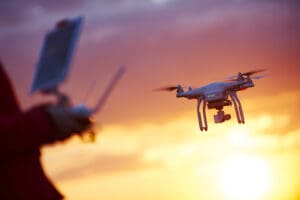 As they continue to grow in popularity, drones are increasingly being included in managed service providers’ (MSPs) hardware and software management packages.
As they continue to grow in popularity, drones are increasingly being included in managed service providers’ (MSPs) hardware and software management packages.
For most MSPs, this is a natural extension, as drones are becoming more widely used in commercial applications, for example, real estate, agriculture, and construction settings. These days they are also are often integrated into company networks, such as inside factories.
“Imagine needing to check a valve on a tank of hot acid in some high-up, difficult-to-reach place; that’s a tailor-made job for a drone,” says Adam Hager, a cybersecurity specialist in Houston.
“However, if an MSP isn’t monitoring a client’s drones, then that could open up a definite vulnerability,” he warns.
CISA recommends increased caution
Drones, with their connectivity and often off-the-shelf security components, can be vulnerable to hacking, so much so that CISA warned this week that businesses should exercise caution when using Chinese-made drones. The CISA warning says, in part:
“Chinese-manufactured drones continue to pose a significant risk to critical infrastructure and U.S. national security. While any UAS could have vulnerabilities that enable data theft or facilitate network compromises, the People’s Republic of China (PRC) has enacted laws that provide the government with expanded legal grounds for accessing and controlling data held by firms in China. The use of Chinese-manufactured UAS requires careful consideration and potential mitigation to reduce risk to networks and sensitive information.”
Many inexpensive drones and their components are manufactured in China, and companies must do their due diligence before purchasing. “As the CISA warning says, any drone can come with security issues, but because of the legal authority given to Chinese manufacturers, CISA thought it needed to make a more strident warning,” Hager notes.
Cybersecurity comes first
No matter where your clients’ drones are manufactured, they increasingly need cybersecurity expertise. MSPs can provide cybersecurity for drones, and it’s becoming an increasingly important service as drone technology and applications advance. Hager says that this is how MSPs can help secure drones:
- Hardening the drone’s operating system involves patching vulnerabilities, disabling unnecessary services, and implementing strong passwords. “Think of the drone as a small, flying computer; you wouldn’t leave a vulnerability on a desktop or tablet; you shouldn’t leave one unpatched on a drone,” Hager advises.
- Encrypting sensitive data includes flight logs, sensor data, and any other information stored on the drone or transmitted during flight. “Going back to our flying computer example, the rule of thumb is if the drone has data, that you would protect anywhere else, then you should protect it on a drone,” he says.
- Installing intrusion detection and prevention systems (IDS/IPS): These systems can monitor the drone’s network traffic for suspicious activity and help prevent cyberattacks.
- Using secure communication protocols: Strong encryption is essential when transmitting data between the drone and the ground control station.
Hager explains there are other tasks MSPs should be on top of when it comes to drones, like securing the ground control station and supporting infrastructure.
“Another crucial job is segmenting the network,” Hager says. This means separating the drone network from other networks to prevent unauthorized access to sensitive data.
Of course, Hager advises, implementing firewalls and intrusion detection systems can help protect the ground control station and support infrastructure from cyberattacks.
Airborne MSP opportunities
According to Grand View Research, the global commercial drone market size was estimated at 19.89 billion USD in 2022 and is expected to grow at a compound annual growth rate of 13.9 percent from 2023 to reach 57.16 billion USD by 2030.
The report goes on to say:
The market growth is attributed to the increasing enterprise application of drones across various industry verticals. Several drone manufacturers are continually testing, inventing, and upgrading solutions for diverse markets. Besides, the integration of modern technologies in commercial drones to deliver enhanced solutions is opening new growth opportunities for the commercial drone industry. The business use cases of commercial drones have expanded significantly over the past few years.
These impressive growth statistics amount to an opportunity for MSPs who constantly must outshine the competition in a crowded market.
“Being able to offer drone security is another way to put yourself ahead of the competition and provide a needed service and value offering to customers,” Hager says.
MSPs can and should help their customers develop a “drone security” policy so that they are seamlessly integrated into the same protocols as laptops, security cameras, and other company hardware.
“Often, a company won’t realize that drones are subject to the same security considerations as other devices. For MSPs, this is a win for the customer and a win for the bottom line by being able to offer an additional service,” he concludes.
Photo: Dmitry Kalinovsky / Shutterstock


I thoroughly enjoyed reading your blog post Kevin, “Drones: Flying security opportunities for MSPs,” and I must say it resonates strongly with the dynamic landscape of managed service providers (MSPs) seeking innovative solutions for their clients. Drones indeed present a compelling frontier for enhancing security services, and your insights shed light on the vast potential this technology holds.